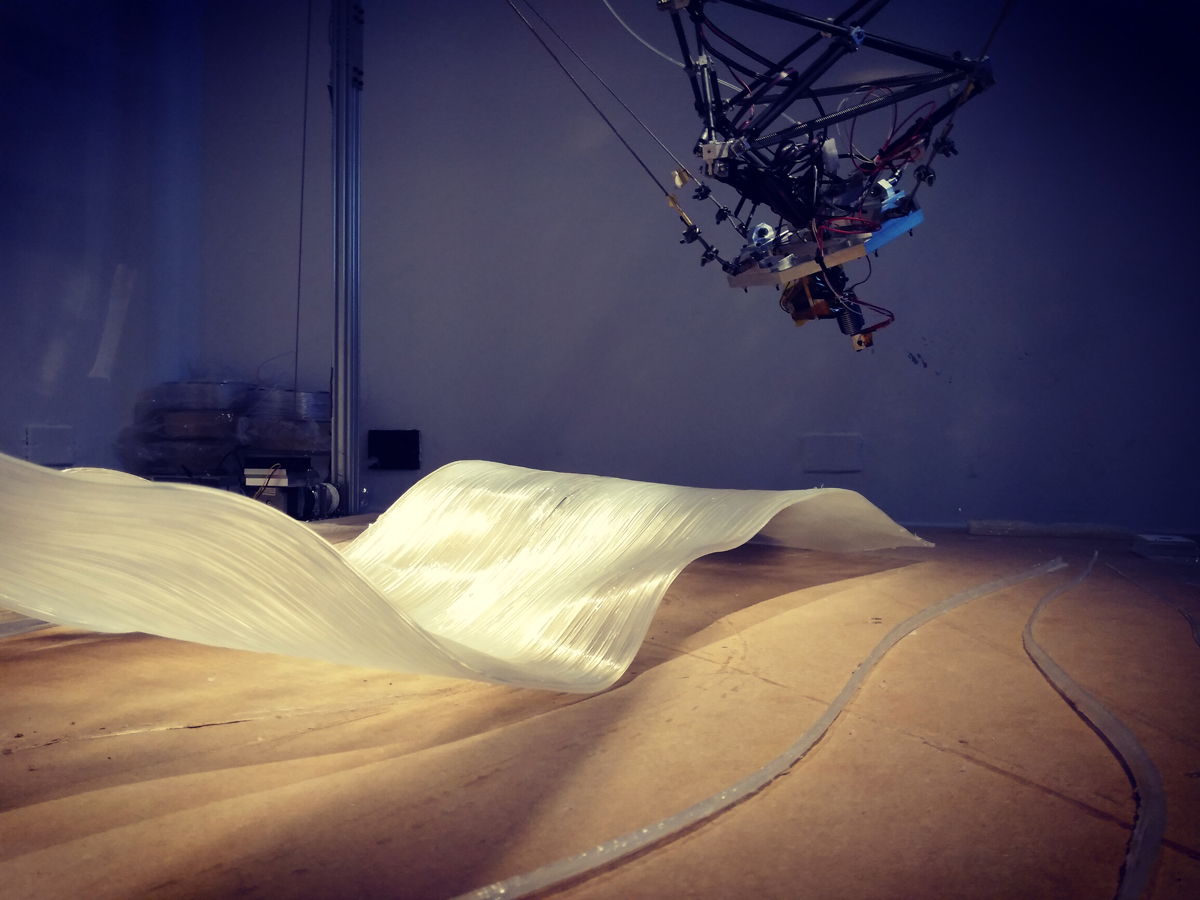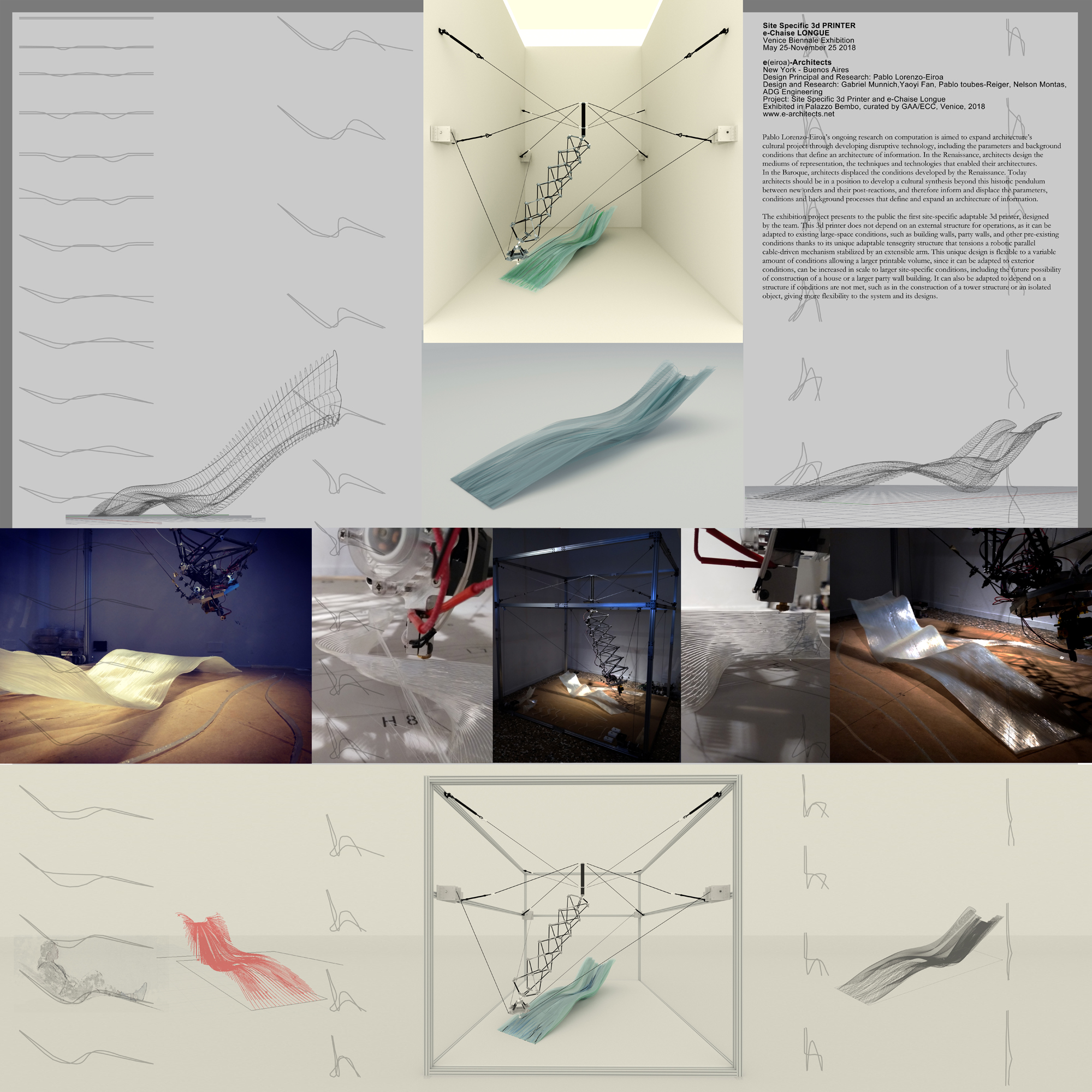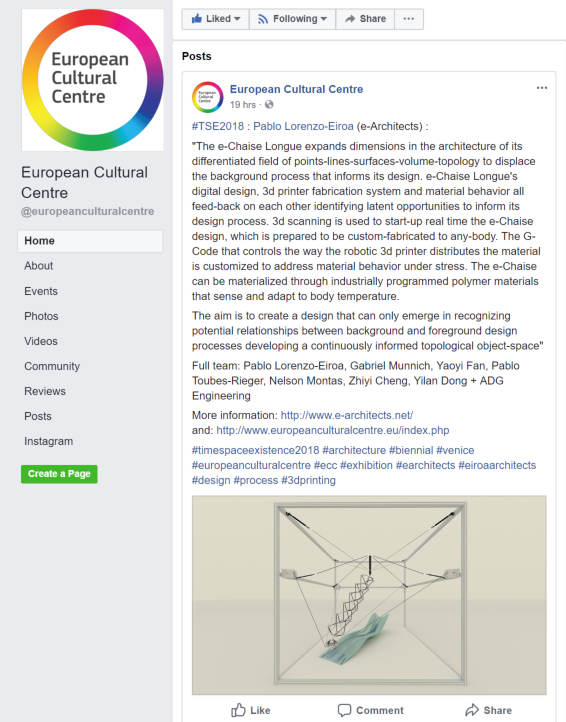2018-05-24/25/26/27 e(eiroa)-Architects was
invited to participate at the XVIth La
Biennale di Venezia International
Architecture Venice Biennale 2018 "Freespace"
Venice Architecture
Biennale 2018,
collateral event
"Time Space
Existence" curated
by GAA Foundation
and the European
Cultural Centre at
Palazzo Bembo, Solo
Room Exhibition: "e-Chaise Longue and
Site-Specific 3d Printer" by
e (eiroa)-Architects; Design Principal and Research:
Pablo Lorenzo-Eiroa; Designers and Research: Gabriel Munnich, Yaoyi
Fan, Pablo Toubes-Reiger, Nelson Montas, Zhiyi Cheng, Yilan Chong + ADG
Engineering (Aamer Islam).
GAA Foundation and European Cultural
Centre curators at
Palazzo Bembo,
Palazzo Mora participants include, among others: Peter Eisenman,
Fumihiko Maki, Odile Decq, Ideal Spaces, Mark Harris,
Jean-Paul Viguier, Nikken Sekkei, SOM and Kengo Kuma,
and a monumental project by Daniel
Libeskind. Palazzo Mora presents the
research of many universities together with a large variety of
photography presentations and international studio projects such as
SOM Chicago and the Mies van der Rohe Foundation. In
addition the Mies van der Rohe Foundation
at Palazzo Mora will present the YTAA Award.
Curators and Organizers: Rachele de Stefano,
Alesia Varnaeva, Valeria Romagnini, Lucia Pedrana,
Elena Volpato, Bianca Bonaldi, Rocco Schenkel, Bérénice Freytag,
Ilaria Marcatelli.
Pablo Lorenzo-Eiroa’s ongoing research
on computation is aimed to expand architecture’s cultural project
through developing disruptive technology, including the parameters
and background conditions that define an architecture of
information.
In the Renaissance, architects design the mediums of representation,
the techniques and technologies that enabled their architectures. In
the Baroque, architects displaced the conditions developed by the
Renaissance. Today architects should be in a position to develop a
cultural synthesis beyond this historic pendulum between new orders
and their post-reactions, and therefore inform and displace the
parameters, conditions and background processes that define and
expand an architecture of information.
The exhibition project will present to the public the first
site-specific adaptable 3d printer, designed by the team. This 3d
printer does not depend on an external structure for operations,
like a spider
it can be adapted to existing large-space conditions, such as
building walls, party walls, and other pre-existing conditions
thanks to its unique adaptable tensegrity structure that tensions a
robotic parallel cable-driven mechanism stabilized by an extensible
arm. This unique design is flexible to a variable amount of
conditions allowing a larger printable volume, since it can be
adapted to exterior conditions, can be increased in scale to larger
site-specific conditions, including the future possibility of
construction of a house or a larger party wall building. It can also
be adapted to depend on a structure if conditions are not met, such
as in the construction of a tower structure or an isolated object,
giving more flexibility to the system and its designs.
e(eiroa)-Architects has been selected by the GAA Foundation and the
European Cultural Centre together with architects such as Peter
Eisenman, Kengo Kuma, Odile Decq, Fumihiko Maki, Daniel Libeskind
and others, to show their innovative work at the Biennale sites. The
e(eiroa)-Architects installation “Site Specific 3d Printer and
e-Chaise Longue” features in the TIME-SPACE-EXISTENCE exhibition at
Venice Palazzo Bembo one of the exhibition shows across Venice.
The installation at Palazzo Bembo features the e-chaise longue
revealing its design as part of its integral relationship to its
materialization process. In the current architecture of information,
usually, design projects are shown as products of a series of
digital processes that are not revealed. In this case, the
background coding processes, as well as the digital fabrication
techniques, including material behavior that enable the design, are
revealed, indexed, displaced and simultaneously paired for the
exhibition, disrupting the typical figure-background condition. The
formal output of the design object and background process that make
them possible are paired at the same level of signification, in
which the form indexes and disrupts its media information process in
a topological reflexive cycle of form in:form.
Site-Specific 3d Printer and e-Chaise Longue” e(eiroa)-Architects:
PI R&D: Pablo Lorenzo-Eiroa, R&D: Gabriel Munnich, Yaoyi Fan, Pablo Toubes-Reiger,
Nelson Montas, Zhiyi Cheng, Yilan Dong and ADG Engineering
PRESS RELEASE:
https://drive.google.com/open?id=1mRIk9UKNkpQAhGoFHBen15FZKEqffVJH
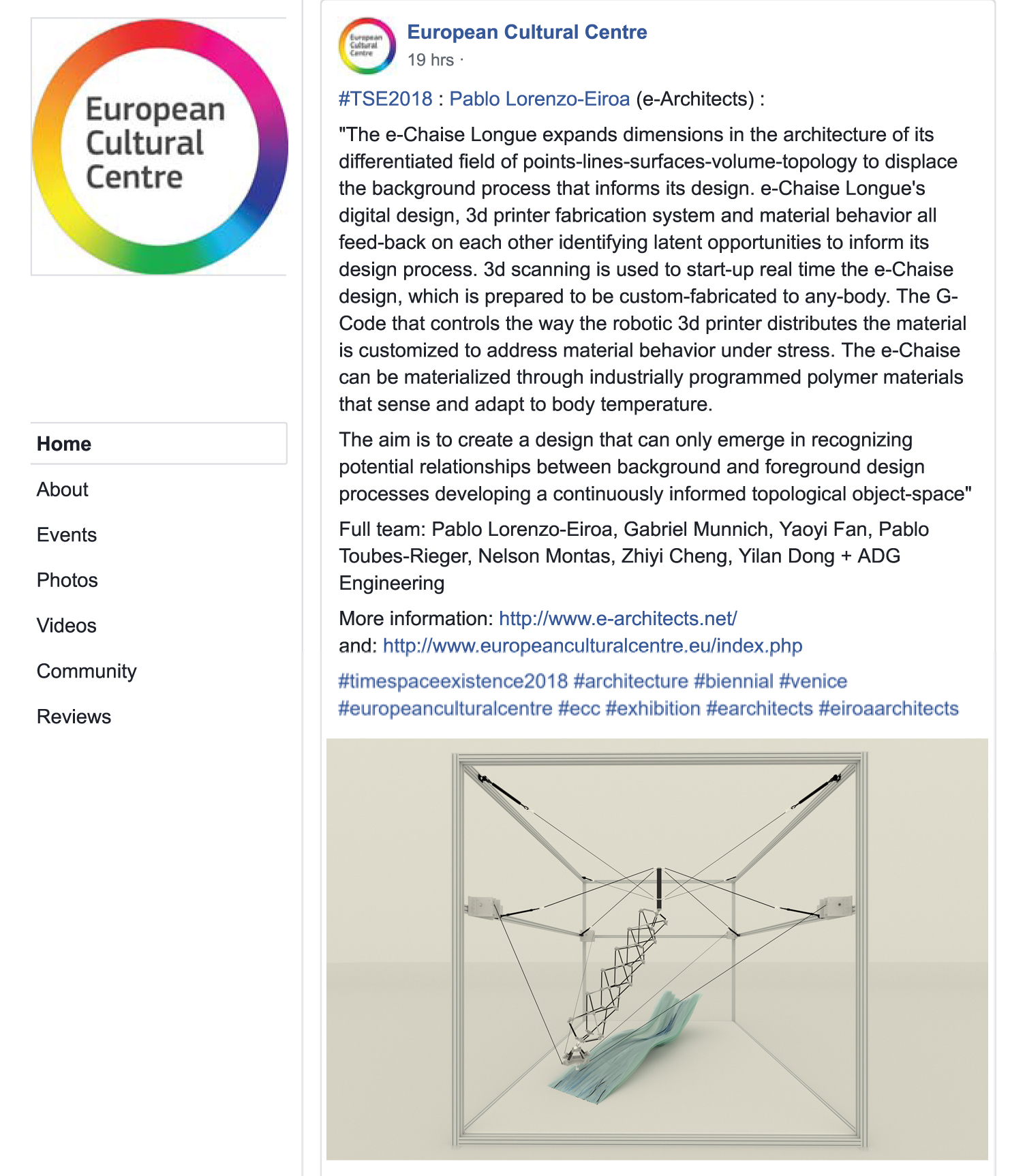
-Architects-2018-02%20copy2.JPG)
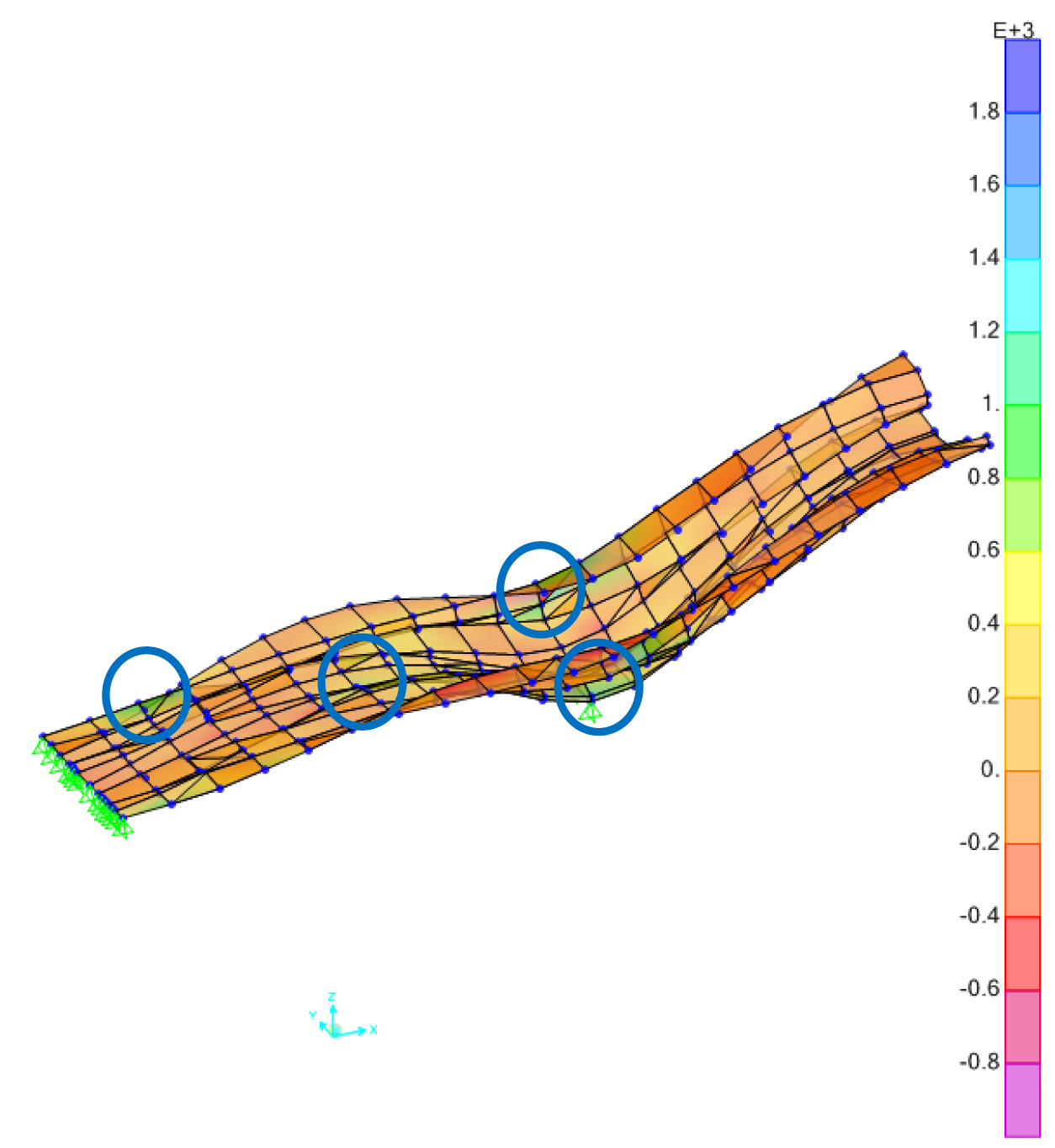
-Architects-2018.JPG)
-Architects-ChaiseLongue-detail-Printing%20copy.jpg)
-Architects-SiteSpecific3dPrinter-VeniveBiennale-2018-GAA-ECC-ea2.JPG)
-Architects-SiteSpecific3dPrinter-VeniveBiennale-2018-GAA-ECC-ea.JPG)
-Architects-SiteSpecific3dPrinter-VeniveBiennale-2018-GAA-ECC-ea-25%20copy.jpg)
-Architects-SiteSpecific3dPrinter-VeniveBiennale-2018-GAA-ECC-ea-22b.JPG)
